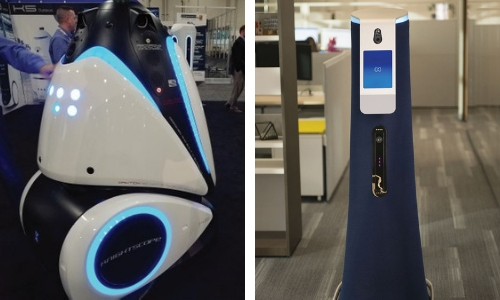One area in which AI is aiding physical security applications is robotics. Indoor robots can be instrumental in providing security personnel with another set of eyes and ears in many locations and notify them of an event so they can respond.
Cobalt Robotics, a leading technology and solutions provider, builds indoor robots that work alongside human guards to provide security. Dr. Travis Deyle, Cobalt co-founder and CEO, reports that robots have the ability to learn which areas in a location need the most coverage.
“Security is all about identifying risks than matching tools to mitigate that risk relative to budget and a location’s existing solutions,” he says.
Robots are ideal for this, as they navigate around an indoor space, build up an understanding of what’s normal and then identify anomalies, Deyle explains. When a robot detects them it remotely notifies a human who can speak through the robot via audio video chat.
Stacy Dean Stephens, executive vice president and chief client officer of Knightscope, a leader in developing autonomous security, adds, “A robot does the boring, monotonous routine work extremely well. By adding robots to an existing program, a user can change the dynamic and allow humans to do the things they do best.”
A former law enforcement officer, Stephens explains that Knightscope robots come equipped with full 360° high definition video, which can be integral from a forensic standpoint.
“Video will give different analytics — facial recognition, LPR, also thermal imaging, such as looking for a fire or thermal event and signal detection for mobile devices. The robot also has the ability to have two-way communication and can speak to people either through prerecorded messages or custom messages.”
Both Knightscope and Cobalt take care to acclimate clients and their staffs to the robots and their capabilities so they feel comfortable working alongside them. Knightscope starts the training early in the process and goes through a predeployment to work through communications. They have someone from their staff conduct a Q&A onsite.
A practice the company has found helpful in endearing the new robot to its co-workers is conducting a naming contest, says Stephens. Employees suggest names and they vote on it.
“It creates a sense of ownership around the robot and makes it like a mascot. Although it is a serious security measure, it definitely impacts their advocacy. It’s like naming a pet — you become attached to it.”
Cobalt also does ‘white-glove onboarding,’ as Deyle describes it. “It’s important; this is a very visible piece of technology that’s going through sensitive spaces. We work with the end user to determine the best way for their organization to adapt to this. We bring the robot in to participate in a Lunch & Learn, so the building occupants know and understand what it is.”
The market for ground robotics is growing. Deyle says Cobalt designs robots to patrol and help deliver surveillance to customers seeking more security in any indoor space, including manufacturing sites, warehouses, museums, data centers, event venues, conference centers, retail spaces and more.
Success stories, Stephens says, are a very effective way to sell the benefits of employing robotic technologies. “The biggest thing is conveying the crime-fighting wins that we have. There are many success stories to tell; we’ve been able to apprehend felons, make arrests in property damage cases, hit and runs, fraudulent insurance claims, and stopped several robberies. It’s great when you can show the effectiveness of the robot especially when there would otherwise be no solving of these crimes.”
Erin Harrington has 20+ years of editorial, marketing and PR experience within the security industry. Contact her at [email protected].
This article originally ran in Campus Safety’s sister publication, Security Sales & Integration.













